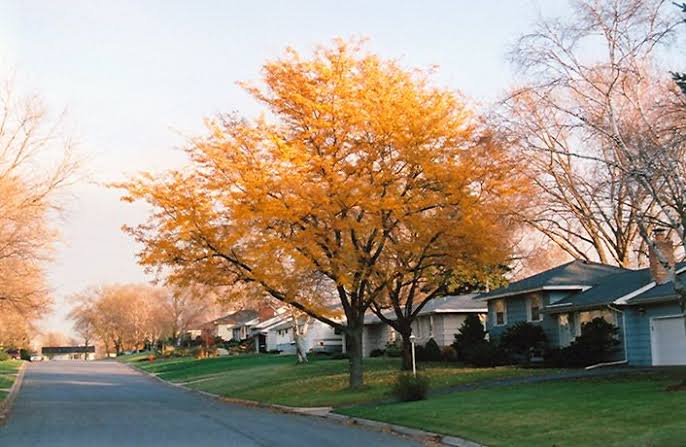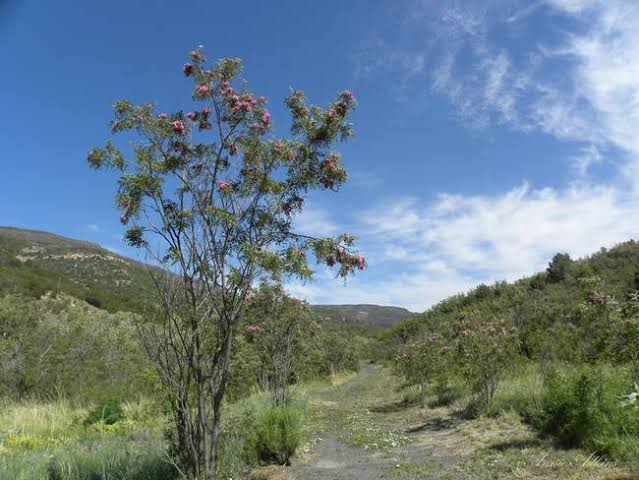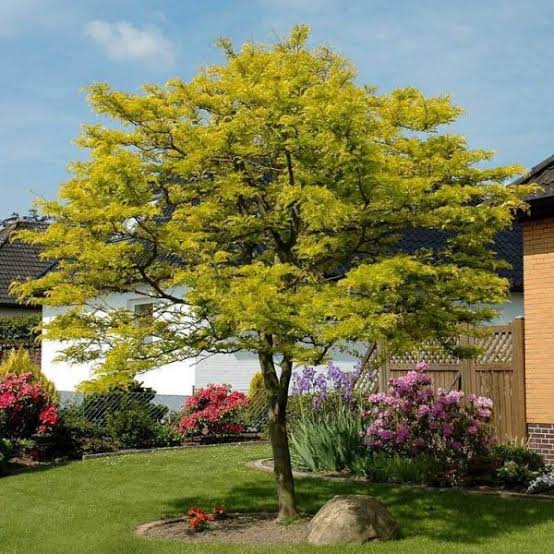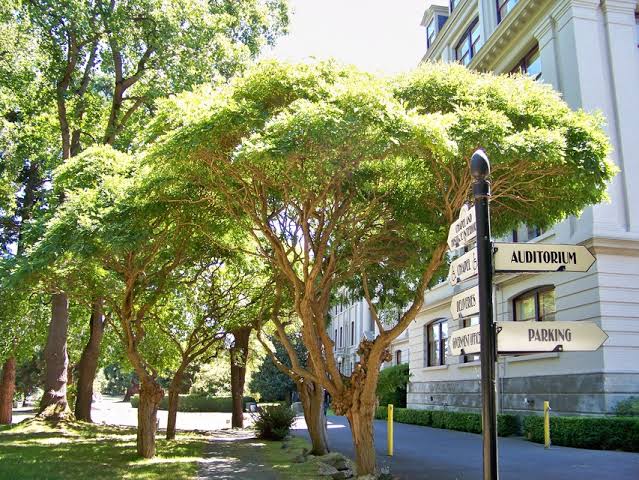Locust tree are members of genus Robinia, a genus of about 10 species of flowering trees and shrubs in pea family (Fabaceae) that grow in North America. Locusts are deciduous and bear long compound leaves with up to 23 oblong leaflets. Many species have thorns. The flowers are often showy and fragrant and hang in loose clusters. The fruits are long flattened legumes. These trees are generally cultivated as ornamentals. The trees are also easy to grow, which has helped them spread and become invasive in many areas in North America.
Generally, locust trees prefer dry soils with good drainage, but can pose a threat to native vegetation when planted near natural areas. It is a native tree as well as invasive in nature, spreading rapidly through profuse seed droppings and invasive root suckers if left untended and unchecked, shading out other vegetation. The large, fragrant flowers compete with other plants for pollination from bees. Leaves bark and seeds are poisonous. In this article, get to understand the 10 varieties or types of locust trees and their uses.
1. Black Locust Tree (Robinia pseudoacaci)

Robinia pseudoacacia, commonly known in its native territory as black locust, is a medium-sized hardwood deciduous tree, belonging to the tribe Robinieae. Black locust reaches a typical height of 40–100 feet (12–30 m) with a diameter of 2–4 feet (0.61–1.22 m). Exceptionally, it may grow up to 52 metres (171 ft) tall and 1.6 metres (5.2 ft) diameter in very old trees. It is a very upright tree with a straight trunk and narrow crown that grows scraggly with age. The dark blue-green compound leaves with a contrasting lighter underside give this tree a beautiful appearance in the wind and contribute to its grace.
Black locust tree is endemic to a few small areas of the United States, but it has been widely planted and naturalized elsewhere in temperate North America, Europe, Southern Africa and Asia and is considered an invasive species in some areas. It is suitable for fuelwood and pulp and provides cover for wildlife, browse for deer and nest cavities for birds.
Botanical Characteristics
- The branchesare typically zig-zaggy and may have ridges and grooves or may be round. When young, they are at first coated with white silvery down; this soon disappears, and they become pale green and afterward reddish or greenish brown.
- The barkis a reddish black and gray and tinged with red or orange in the grooves. It is deeply furrowed into grooves and ridges which run up and down the trunk and often cross and form diamond shapes.
- Woodis pale yellowish brown, heavy, hard, strong, close-grained, and very durable in contact with the ground.
- The leavesare compound, meaning that each leaf contains many smaller leaf like structures called leaflets, which are roughly paired on either side of the stem that runs through the leaf (rachis).
- Black locust will adapt to many soils, except those that are permanently wet. It performs best on moist, loamy soils of limestone origin. Black locust transplants easily. It fixes nitrogen, partially creating its own supply of nitrogen.
2. Honey Locust (Gleditsia triacanthos)

The honey locust (Gleditsia triacanthos), also referred to as the thorny locust or thorny honeylocust, is a deciduous tree native to the subtropical forests of North and South America, Asia and Africa. The honey locust can reach a height of 20–30 m (66–98 ft). They exhibit fast growth, but live a medium-long life span of about 120 years.
The leaves are pinnately compound on older trees but bipinnately compound on vigorous young trees. The leaflets are 1.5–2.5 cm (0.6–1 in) (smaller on bipinnate leaves) and bright green. They turn yellow in the autumn. Honey locusts leaf out relatively late in spring, but generally slightly earlier than the black locust (Robinia pseudoacacia). The strongly scented cream-colored flowers appear in late spring, in clusters emerging from the base of the leaf axils. These are tough, fast-growing trees that tolerate challenging urban conditions, such as drought, pollution, salt, compacted soil, heat, and alkaline soils.
Botanical Characteristic
- Botanical Name: Gleditsia triacanthos
- Bark: The bark is gray to gray-brown, furrowed and with thorns.
- Fruit: The dark brown fruit pods are up to 40 cm (15.75 in) long. They are crescent-shaped, conspicuous and falling down. The seeds taste sweet.
- Blossom description: The greenish small flowers are arranged in grape-like and sprout along with the leaves.
- Branches: The branches are thorny and they takes very well cutting.
- Root: Deep-rooting plant, taproot forming
3. Skyline Honey Locust (Gleditsia triacanthos f. inermis ‘Skycole’)

Skyline Honey locust is a medium-sized flowering deciduous tree with a distinctive and refined pyramidal form. It lends an extremely fine and delicate texture to the landscape composition which can make it a great accent feature on this basis alone. Skyline Honeylocust has dark green foliage throughout the season. The pinnately compound leaves turn an outstanding gold in the fall.
Skyline Honey locust typically grows 60–80 feet tall with a rounded spreading crown. Inconspicuous, greenish yellow to greenish white flowers appear in racemes in late spring. Flowers are followed by long, twisted, and flattened, dark purplish-brown seedpods (to 18 inches long) that mature in late summer and persist well into winter. Seedpods contain, in addition to seeds, a sweet gummy substance that gives honey locust its common name. Skyline honey locust is a thornless variety with a stronger upright growth form, few seed pods, and excellent yellow fall color. This is an adaptable tree especially good for streets and parking lots.
Botanical Characteristic
- Growth habit: Fast
- Average landscape size:Grows 60-80’ (less frequently to 120’) tall
- Foliage color:Dark color
- Blooms:Spring
- Flower color: Greenish-yellow
- Flower attributes: Fragrant
- Garden style: Asian/Zen, Cottage, Rustic
4. Bristly Locust (Robinia hispida)

Robinia hispida, known as the bristly locust, rose-acacia, or moss locust, is a shrub that grows to 3 meters tall, often with glandular, bristly (hispid) stems. The leaves are pinnate with up to 13 leaflets. The pink or purplish pealike flowers are borne in hanging racemes of up to 5. The fruit is a flat pod. It is native to the southeastern United States, and it is present in other areas, including other regions of North America, as an introduced species. It is grown as an ornamental and can escape cultivation and grow in the wild.
Botanical Characteristic
- Appearance: Robinia hispidais a deciduous shrub, to 8 ft. The multiple stems are erect and covered with dense bristles.
- Foliage: The alternate, pinnately compound leaves have 7 – 19 leaflets about 1.5-2 in. long. They are densely hairy with smooth edges. Most leaves have a pair of long spines at their base.
- Flowers: The dark to light pink pea like flowers are clustered in the leaf axils. The flowers bloom from May through June.
- Fruit: The thin seed pods are 2-4 in. long and densely covered with bristly hairs.
- Growth: Robinia hispidawas planted for erosion control and can be found in disturbed areas such as old fields and along roadsides. It prefers full sun.
- Habitat: Native to the southern United States.
5. Imperial Honey Locust (Gleditsia triacanthos var. inermis ‘Imperial’)

Valued for its delicate fern-like leaves, the Imperial honeylocust (Gleditsia triacanthos var. inermis ‘Imperial’) is one of the most popular shade trees. This thornless tree features bright green foliage that creates a rounded crown above the trunk. The Imperial honeylocust produces a few seed pods in the summer, and the green leaves slowly fade into a yellow color by the fall. Unlike other honeylocust species that have thorns, this variety does not produce any barbs. The Imperial honeylocust is an excellent choice to add to your landscape.
This deciduous tree produces medium-sized leaves. The fern-like leaves are composed of numerous leaflets with serrated edges. Throughout the year, you can expect to see bright green foliage. As the summer season changes towards autumn, these leaves will turn into a brilliant shade of yellow.
The Imperial honeylocust is a low-maintenance tree. With its broad habit of growth, it will leaf out later than other shade trees. In one way, this action protects the tree from late spring freezes and heavy snows. These trees can be used in large parking lot islands. Along sidewalks or highways, they are also recommended for buffer or median strips.
Botanical Characteristic
- Plant type:Shrub
- Deciduous/evergreen: Semi-evergreen
- Growth rate:Moderate
- Average landscape size:Moderate growing; reaches 3 ft. tall, 4 ft. wide.
- Blooms: Spring, often repeating in fall.
- Flower color: Pink
- Flower attributes: Fragrant, Showy Flowers
6. New Mexico Locust (Robinia neomexicana)

Robinia neomexicana, also referred to as the New Mexican, New Mexico, Southwest, desert, pink, or rose locust), is a shrub or small tree that grows to 5–10 m tall (rarely to 15 m) with bristly shoots. The leaves are 10–15 cm long, pinnate with 7–15 leaflets; they have a pair of sharp, reddish-brown thorns at the base. The flowers are showy and white or pink, and considered fragrant. Blooms are produced in spring or early summer in dense racemes 5–10 cm long that hang from the branches near the ends. The fruits are brown bean-like pods with bristles like those on the shoots. The twigs are grayish brown and have a pair of stout, sharp, curved thorns at the nodes. The young twigs are reddish and glandular-hairy. The bark is grayish, smooth when young, and furrowed when old. The fast-growing plants are suckering and thicket-forming large shrubs or small trees.
The wood is hard, heavy, and durable, but trees seldom grow large enough to be sawed into lumber. The wood is sometimes used for items like tool handles, and for fence posts. Perhaps, though, the best thing about New Mexico locust is just that it is an easy to identify attractive little tree that adds color and diversity to the landscape.
Botanical Characteristic
- Size:5–10 m tall (rarely to 15 m)
- Growth Form:Tree and large shrub; dense crown, spiny spreads through rhizomes which also form thickets, trunk diameter to 8 inches, dense crown.
- Leaves:Green; alternate, deciduous, pinnately compound, leaves to 8 inches.
- Flower Color: Purple, white or purplish-pink; showy flowers in axillary racemes, fragrant, pea-shaped, hanging in dense clusters, fruit a 3 inch hairy legume, several seeds.
- Soil Description:Rocky soils. Sandy, Sandy Loam, Medium Loam, Clay Loam, Clay
7. Purple Robe Black Locust

‘Purple Robe’ locust is a tremendous medium sized, suckering, deciduous shade tree that typically grows tall with an oval-upright habit. It forms an oval-upright canopy. The leaves are odd pinately compound with up to 23 lance-shaped to ovate leaflets. In the spring the leaves emerge bronze-red but turn to green during the summer before turning yellow in the fall. It also develops long clusters of purple-colored flowers in May that resemble Wisteria flowers. These beautifully fragrant clusters cover the tree profusely that grows up to eight inches long each. The tree reaches 30 to 50 feet tall at maturity, and its oval canopy spreads 20 to 35 feet wide.
The “Purple Robe” black locust has an invasive root system, even in the poorest soils, which sends up suckers. This tendency, plus extensive reseeding from birds and other mammals, contributes to a dense thicket that forms around the mother plant when left alone. In some areas, it is considered invasive, spreading through the landscape and interfering with other plants. The tree provides good dappled shade, but has sharp thorns on its branches.
“Purple Robe” can grow in full sun or light shade, and in almost any type of well-draining soil, from acidic to alkaline and dry to moist. Aphids, scale insects, whiteflies and caterpillars can also become problems on this tree, although these are usually less serious. Diseases that often plague the “Purple Robe” black locust include powdery mildew, canker, leaf spots and root rots.
Botanical Characteristics
- Bloom Time: May
- Bloom Description: Violet purple
- Sun: Full sun
- Water: Dry to medium
- Maintenance: Medium
- Suggested Use: Street Tree, Flowering Tree, Naturalize
- Flower: Showy, Fragrant
8. Shademaster Honey Locust

Shademaster Honeylocust is an open deciduous tree with an upright spreading habit of growth. It lends an extremely fine and delicate texture to the landscape composition which can make it a great accent feature on this basis alone.The Shademaster Honeylocust is known for its dark green foliage throughout the year. Its pinnately compound leaves turn to a beautiful yellow hue during the fall. This tree does not produce any fruit or flowers.
Honeylocust trees are native to North America, and they are chosen for their hardiness in most conditions. The Shademaster variety is hardy than most trees, and they do not have large seed pods or sharp thorns like other honeylocusts.
Shademaster Honeylocust will grow to be about 45 feet tall at maturity, with a spread of 40 feet. It has a high canopy of foliage that sits well above the ground, and should not be planted underneath power lines. As it matures, the lower branches of this tree can be strategically removed to create a high enough canopy to support unobstructed human traffic underneath. It grows at a fast rate, and under ideal conditions can be expected to live for 70 years or more.
Botanical Characteristics
- Botanical Name:Gleditsia triacanthos var. inermis ‘Shademaster’
- Mature Height:50 – 75 feet
- Mature Spread:25 – 40 feet
- Sun Exposure:Full Sun, Partial Shade
- Soil Type:Widely Adaptable
- Moisture:Moderate, then Low
- Growth Rate:Fast
- Foliage:Deciduous
- Foliage Color:Green
- Fall Color:Yellow
9. Sunburst Honey Locust

The Sunburst honey locust is native to the Midwestern United States where it grows in moist and winter-cold locations. It is a fast growing tree with an arching branch habit, reaching 35-50 ft. tall, 30-35 ft. wide. The new growth of this cultivar is bright yellow and very attractive. Flowers are inconspicuous; clusters of 12-18 in. long flattened brown bean-like seed pods ripen by end of summer.
Sunburst honey locust has proven to be a tough and highly adaptable tree that is grown for shade in parks and gardens. It is best adapted to loam soils, and with regular summer moisture it has proven to endure sun, heat and aridity. Mature trees will endure short periods of summer drought. It is widely appreciated for its graceful branching habit and moderate shade during the summer.
Botanical Characteristics
- Growth Rate: Fast
- Height: 25 ft. – 30 ft.
- Width: 25 ft. – 30 ft
- Water Needs: Moderate
- Foliage Color: Medium green
- Flower Color: Insignificant, Green
- Flower Season: Spring
- Soil Adaptations: Moist soil, Loam, Clay
- Exposure Adaptations: Heat, Drought, Aridity, All day sun
- Function: Specimen, Shade Tree, Parks and open space, Foliage accent plant, Civic spaces, Background plant
10. Umbrella Locust (Robinia pseudoacacia ‘’Umbraculifera’’

Umbrella locust is a dwarf form of locust tree that reaches 20 feet in height. It has an umbrella-shaped, dense canopy, with 6-14 inch, dark green leaves and multiple leaflets on twigs. The trees are drought and salt tolerant, making them good trees for dry or seaside areas. Umbrella locust trees produce large, cream-colored, fragrant clusters of pea-like flowers that produce 1-4 inch-long dark red, brown or black seed pods. Umbrella locust trees are grown for their unusual umbrella shaped canopy as ornamental display species.